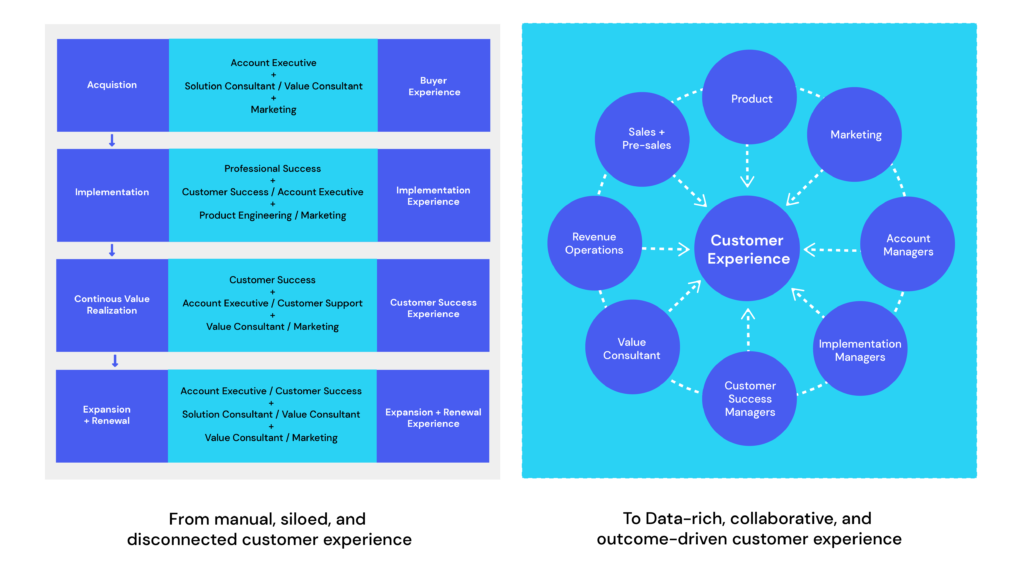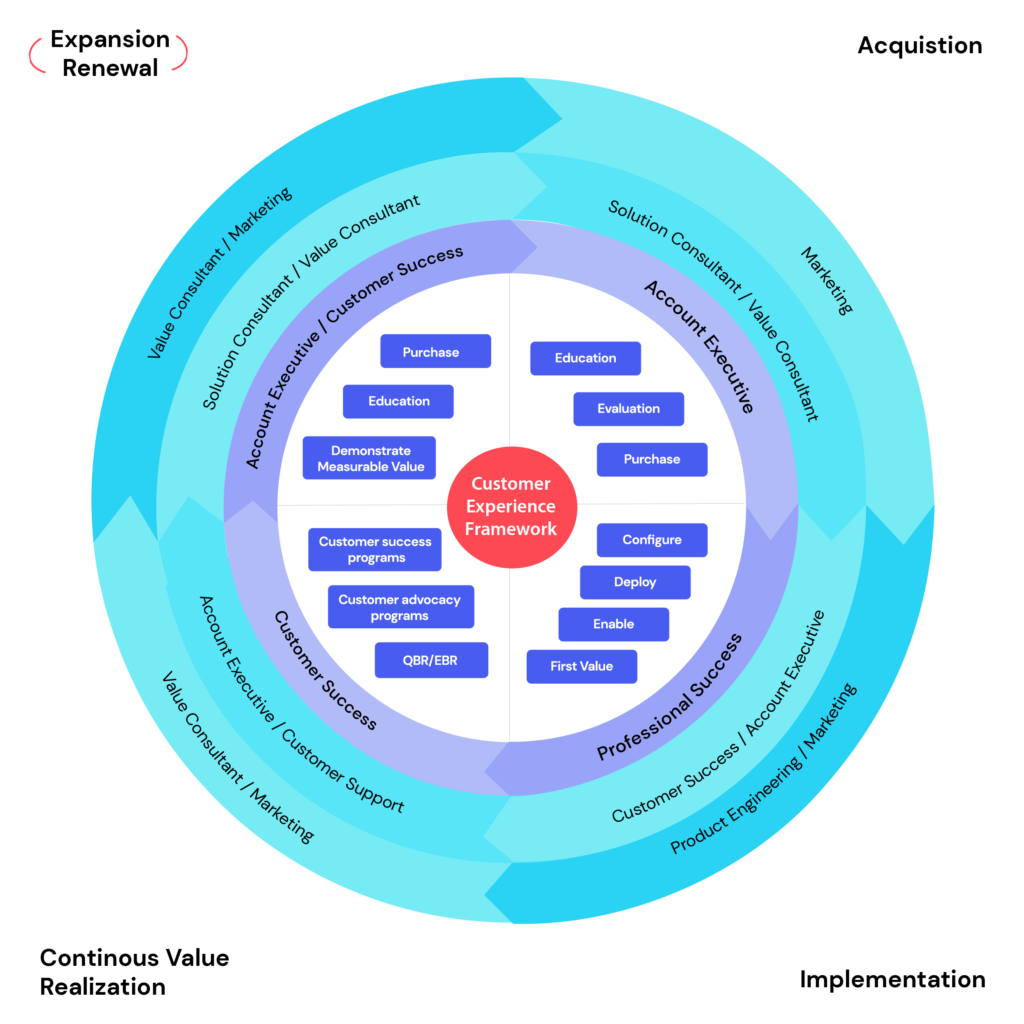 BACK TO BLOG
BACK TO BLOG
Future of B2B Customer Experience: Unify sales and post-sales

 BACK TO BLOG
BACK TO BLOG

Your team has worked 4 months to win a $150K land. There were about 5-6 internal stakeholders and 12-15 customer stakeholders involved in the evaluation. After the contract is signed, your sales team submits a 2-3 page sales to customer success handoff document along with a handoff call to transfer 4 months of insights in <1 hour of effort.
Does this sound familiar to you? What is the challenge with this? Your implementation and customer success teams start from scratch, i.e., discovery, solution demo, realign on value, etc., all of which leads to critical time being lost and, more importantly, suboptimal b2b customer experience. To top it off, the salesperson is also forecasting a $300K upsell later in the same fiscal year.
If you are like most revenue leaders, this should sound like a typical set of challenges in the land and expand the playbook. Perhaps the top 2% of customers are getting executive attention, hence an integrated and seamless flow of customer context and information. But what about the other 98%?
This blog aims to give the revenue leaders like you at SaaS companies a framework and methodology for developing a GTM strategy that puts customer success at the center of everything you do.
Knowing the answer to this question is fundamental to the growth and success of your business. It is also important to know that there is no single answer to this question. It will involve all your go-to-market teams to work collaboratively.
A predictable b2b customer experience starts with the sales team clearly understanding the value creation opportunity, your implementation team setting the right foundation for value realization, and your customer success teams continuing to reinforce value delivered and finding new value-creating opportunities for the customer that the customer can realize using your product or service.
Customer Success centric organization needs a cross-functional strategy designed and executed to drive alignment and transparency between internal teams and the customer. If executed well, it will impact the following areas:
Answering this simple question of how to help customers realize value will need you to develop a strategy around the following areas:
If you are like most organizations, you look at customer success as a separate function from revenue teams. In fact, your customer success team could itself be split into services, support, and customer success.

The problem with this kind of arrangement (left side) is that the information flow is never smooth, leading to poor operational efficiency and effectiveness.
The best ‘customer-success centric organizations’(right side) fundamentally redesign their GTM playbook around the customer… All your GTM teams will align themselves around three things your customers’ care about - value discovery, value collaboration, and value enablement; Internal teams and customers work on a shared understanding of each of these items across the entire relationship lifecycle. This enables everyone to have equal access to customer context leading to better experience and operational effectiveness.
To ensure there is a maniacal focus on customer success, having detailed role definitions to drive clarity on each person’s KPIs and the interaction with customers will be crucial. Each team has its unique role to play:
| 1 | Sales + Pre-sales: |
|
| 2 | Implementation Managers: |
|
| 3 | Value Consultants: |
|
| 4 | Customer Success Managers: |
|
| 5 | Account Managers: |
|
| 6 | Revenue Operations: |
|
| 7 | Product: |
|
| 8 | Marketing: |
|
Most B2B companies have a combination of these eight roles to service their customers. The challenge is that each of these teams has its own independent playbook/touchpoints, and the best version of what is happening with the customer is in several places, some of which may sync to your CRM, internal emails, slack threads, presentations, and excel files. While this is already messy, your customers do not even have this integrated view leading to a disjointed experience and breakdown of trust (unless you got superhuman taking care of the account)



Establishing true cross-functional alignment.
To operationalize a customer success strategy, you need to align your internal teams to work in tandem toward the same objectives and vision. Having a framework that revolves around your customer journey and is focused on their goals and objectives will be fundamental to drive this alignment.
Enable interactions that help you identify and define potential value for your buyers and create a plan to get there.
LEARN MOREPartner with your buying teams across personalized milestones and a jointly developed roadmap to buyer success.
LEARN MOREEmpower your buyers with one-place-to-go for accessing contextually relevant information at any time.
LEARN MOREUnify all the buyer behavior data across their lifetime engagement to make business decisions.
LEARN MOREIn the world of SaaS, there are no forever customers. No matter how good your product is, the moment you stop delivering value, you are at risk of churn. The positive side to this is when you deliver value, there are more cross-sell and upsell opportunities.
Before starting BuyerAssist, I was a global account executive at a Unicorn startup and grew one of our strategic customers from low five-figure value to mid-seven-figure in <18 months. As I look back at the customer journey, one of the things we did really well was to align the broader organization and the customer on the shared understanding of the customer context. We had nailed down the understanding of the broader enterprise-level transformation, how our solution solves the customers’ pain point and the material value we can deliver at each stage of the value realization journey. As the global account executive, I was tasked with doing Account Plans, Mutual Success plans, internal ownership of enabling the cross-functional team to work in a certain cadence, and ultimately working strategically with the customer from land, expansion, and renewals.
But as I look back it, there were three problems:
If my guess is correct, you are thinking, what does customer value, collaboration, and enablement have to do with all of this. One of my learnings in this customer engagement was that ultimately all of the things that salespeople do around account plans, mutual success plans, org charts, etc., are at the service of two things.
(i) do we understand the value opportunity clearly? Does the customer agree with it? Does the customer also define it in the same way? How can our solution/service help customers realize the desired value in a reasonable timeframe?
(ii) are all of us (internal and external) having the same shared understanding? Do we all know what we need to do for the customer to realize value, i.e., the steps in the process? Does the customer know their actions in the pre-buying, post-buying process? Are you collaborating actively?
A lot of the genesis of the BuyerAssist is to answer the simple question - how do we systematize trust and transparency in every B2B relationship?
My belief is that digital will be the primary medium to sustain trust through radical transparency. Having a systematic and digital-first approach to connecting the customer's dots across the relationship life cycle will increasingly become a must-have. Value communication, collaboration, and buyer enablement will be core tentacles of such a system.
If you are like any high-growth company, you will have several teams responsible for customer success. Having an integrated approach where all these teams are working in tandem with the customer at the center is a potential game-changer. In fact, 70-80% of revenue in any growth stage company comes from existing customers (renewals + expansions). Having a strategic approach to customer value, collaboration and buyer enablement drive high impact with customers. Despite the clear correlation, many growth-stage companies do not do enough to align all internal teams and the customer on a shared definition of the engagement.
Having an integrated GTM playbook is definitely a starting point as you evaluate where to start this integration. Look at commonalities between your sales and customer success playbook but also professional services. Look for areas where you can tie them together. The most mature organizations have a GTM playbook that guides the respective teams on the why, how, and what.








